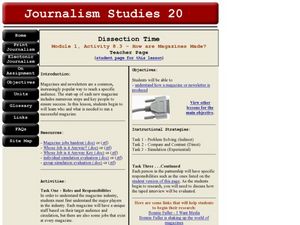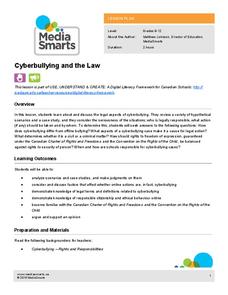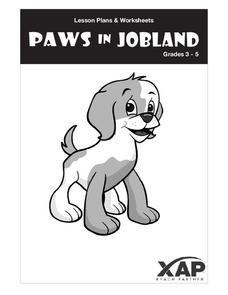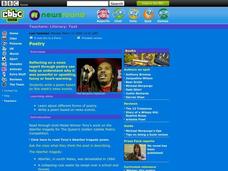Curated OER
Who, What, Where, When, Why, How
Students take a closer look at the organization of news stories. For this journalism lesson, students identify the elements of news stories and then write their news stories on the same topics using different types of leads.
Curated OER
Part of it All
Students take a closer look at the organization of newspapers. In this journalism lesson, students take virtual tours of newspapers and complete a newspaper puzzle handout. Students then compare the layout of weekly rural newspapers to...
Curated OER
Dissection Time
Young scholars take a closer look at the organization of magazines. In this journalism lesson, students complete handouts about the jobs and responsibilities in the magazine industry. Young scholars then learn about the steps of...
Curated OER
Make a Mockery of Magazines
Learners examine tabloids. In this journalism lesson, students compare and contrast satirical magazines and then plan, write, and compile their own.
Curated OER
Asking the Right Questions
Students explore interviewing skills. In this journalism lesson, students examine "good" and "bad" interview questions and discuss both. Students then practice interviewing partners in the classroom.
Curated OER
Writing a News Report
Students explore journalism by analyzing current events. In this news report lesson plan, students identify important questions to ask during an interview and discuss a fictitious news story about a missing teacher. Students read...
Curated OER
Radio News
Part of a larger unit from the Media Awareness Network on media literacy, this particular lesson plan focuses on the medium of news radio. Small groups participate in discussions on their radio listening habits as well as the...
Curated OER
Conditions of City Life in the Late 19th Century
Students examine tenement life. In this lesson on early urbanization, students research the role of journalism for social change in early American cities. Students write a journal article for themselves that demonstrate an understanding...
Curated OER
Teach and Learn: Journalism
Students read and discuss keypoints of the article, "Iceland to start hunting whales." They write in the style of newspaper reporters and order the information so that it tells the story from beginning to end with relevant detail
Media Smarts
Cyberbullying and the Law
Research, role-playing, and reflection are the three “R’s” that form the basis of an examination of Cyberbullying. Although based on the Criminal Code of Canada, the included scenarios and case studies provide valuable resources for a...
Curated OER
Teaching The Personality Profile
Students write a comprehensive personality profile feature that demonstrates knowledge of the Wall Street Journal formula of feature writing and the concept of show, don't tell. They experience a press conference interview situation.
Curated OER
Journalist Japes
Students explore the job of a journalist. In this careers and writing lesson, the teacher introduces the job of a journalist, then students choose a headline and write a news story. Lesson includes extension ideas.
Curated OER
Kids' Newsbreaks
Group learners together to identify a question relating to an issue and create a 60-second kids news break highlighting information that begins to answer the question. They research and answer issue questions in a news story format.
Stanford University
Hurricane Katrina
The adage says that journalism is the first draft of history. How should people evaluate these sources of information? Taking into account various sources, including those from various perspectives and different creators, learners...
Curated OER
Information Texts
Students recognize features of information texts. Students analyze each texts' importance in journalism. Students relate these features to their own environments. Students share findings with the class.
Curated OER
News
How does broadcast news differ from accounts reported in newspapers? On the radio? Through the Internet? Middle schoolers discuss the news and speak about the differences between news in print and broadcast news. Given a list of six...
Curated OER
Fairy Tale Press
Students create the front page of a newspaper by writing news stories about the main characters and plots of fairy tales.
Curated OER
Evaluating Reports
Students critically evaluate texts aimed at a young news audience. Students discuss the strengths and weaknesses of certain text. Students evaluate what effect the headlines and summaries have on young people.
Curated OER
Summarizing
Young scholars analyze and summarize the main aspects of a news story. They find the "Who, What, Where, When and Why in a particular news story.In addition, they answer six questions over a particular story and then write a news story...
Curated OER
Poetry
Students reflect on a news report through poetry. Students write a poem based on this week's news events. Students share poems with each other. Students reflect on a poem of their choosing.
Curated OER
The Influence of Advertising
Students analyze advertisements and develop guidelines for viewing advertising. In this advertising lesson, students discuss print ads, TV commercials, and other examples of ads. Students survey their friends or relatives about their...
Curated OER
Newspaper Writing on Flight in History
Students read about important events in history through newspaper articles. For this newspaper lesson, students look at different writing styles and author's bias in different articles about the same event. They write their own articles...
University of the Desert
Do Journalists Shape or Report the News?
Analyze the presence of negative stereotypes and biased reporting in news media, and how this affects one's understanding of other cultures. Learners read newspaper excerpts and quotes from famous personalities to discuss...
Curated OER
Aztec Myths: Writing Editorials
Middle schoolers write an editorial giving an opinion of whether or not Quetzalcoatl has arrived and if so, what the Aztecs should do. They discuss whether or not they believe Quetzalcoatl is a god or a man, and use an Editorial...

























